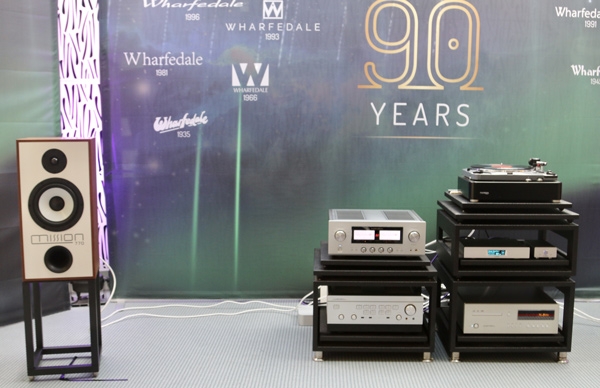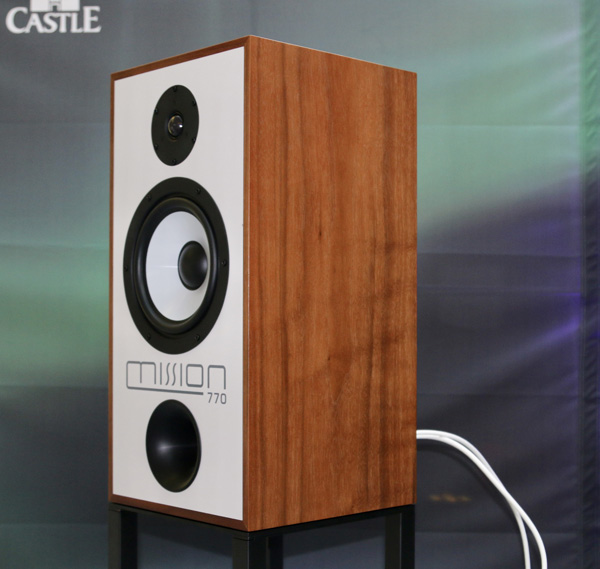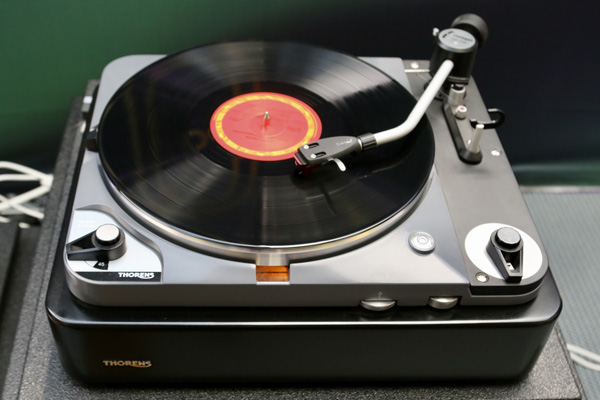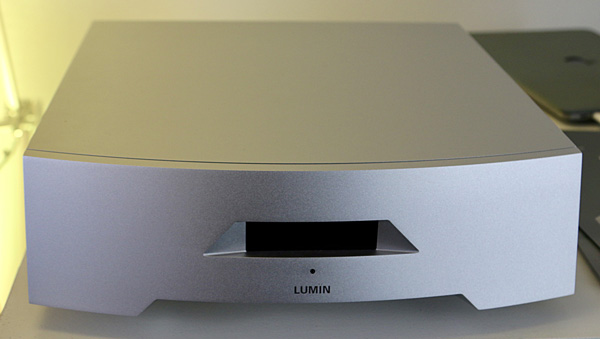| Columns Retired Columns & Blogs |
Isn't Luxman Japanese?

The two-way 770 is a "true 8-ohm speaker" with an 88dB/W/m sensitivity specification. The soft-dome tweeter is housed inside its own rear chamber. Mission was among the first companies to use polypropylene cones, he told me. The drive unit is similar, but the magnet and motor system are much bigger than the original's. Copper caps on the drive-unit former lower distortion; the crossover capacitors are polypropylene.

The 770 has heavily flared ports inside and out for bass extension, which is said to go down to 30Hz. The cabinet, which was formerly made of heavily damped thin wood, BBC-style, has received major upgrades, Comeau said. It's constrained-layer-damped now with an inner layer of "chop board" with MDF layered on top and damping glue in between. The 770s are still made in Huntingdon, England—just down the road from Mission's first factory—and are in market now. Stands are included.

Another case of old-meets-new: the vintage Thorens TD124 direct drive turntable that served as the setup's analog source was kitted out with the new Luxman LMC-5 MC cartridge ($2695). The Luxman L-507Z integrated amplifier with onboard phono stage provided amplification. The demo system's digital sources included a Luxman D-10X CD player/DAC and the new Lumin U2 Mini network streaming transport and Lumin L1 NAS.

Speaking of digital sources, the recently released Lumin Music Systems P1 network DAC/preamp/music streamer/player was on passive display. The Lumin P1 is equipped with a host of digital inputs—plus a pair each of analog RCA and XLR inputs—USB Audio (Class 2 compatible), and three HMDI connections, including PCM 2.0 Audio, ARC, and 4K video pass-through for home theater fans. Digital outputs include USB with native DSD512 support and up to 32-bit/384kHz PCM, BNC S/PDIF up to DSD64 (DoP64, DSD over PCM), according to the press sheet. The P1 is Roon Ready and supports Apple AirPlay, Tidal Connect, and Qobuz, among other streaming services—and full MQA decoding and rendering. As JA discussed in his April 2022 review of the P1, it features Leedh Processing for the digital volume control, which deploys a new adjustment algorithm said to eliminate rounding errors. This French technology reportedly reduces or eliminates truncation-related loss of signal information in conversion. The Lumin P1 comes in anodized aluminum or with black finish, and ships with an infrared remote control with Austrian glass.
I didn't listen long in here but some familiar tracks—from Daft Punk's Random Access Memories LP, for example—sounded full and, well, like music. A throwback track, Enigma's "Sadeness (Part I)" also brought synthesized fun, plus flute flourishes. (And I'd forgotten that Enigma was a German group. Interesting that this downtempo hit came out circa 1990, not long after the Berlin Wall came down.) In general, playback seemed understated in a good way—undoctored, not tampered with. Maybe monitor-like? Highs weren't tipped up, low-end wasn't bloated. As noted, bass is said to extend down to 30Hz. Not bad for a stand-mounted speaker this size.

Luxman was founded and initially manufactured in Japan. It is now owned by the International Audio Group (IAG). According to Wikipedia, that quasi-omnipotent inanimate fount of all information correct or otherwise, "the IAG has purchased several British HiFi manufacturers: Audiolab, Wharfedale, Quad Electroacoustics, Mission, Tag McLaren, and Castle Acoustics, Luxman, plus several Italian manufacturers of lighting equipment including f.a.l. and Coef."
[Edit: The Wikipedia entry goes on to mention that Luxman has factories in China; in fact, after some brief experiments with Chinese manufacturing, Luxman now assembles all its products in Japan (some from parts made in China); and the vast majority of Luxman products are entirely manufactured in Japan.]

A random aside: I had a Luxman dual cassette deck with all kinds of functions in my latter teenage years. Wish I could think of the model number...might have to look into that. It was the ultimate mixtape-making machine!

At least, I respect the fact that IAG seems to respect the time-honoured brands it has hoovered up in the past decade or so. Clearly the designers it employs are doing their best to maintain the spirit of the original marques, if nothing else.
HOWEVER:
Would I rather have a Quad amp that was hand-built by some funny music-loving dudes at Quad in Britain in the 1970s, or a Quad replica (for that is what most of the products pushed out by IAG are) coming off a conveyor belt in China 50 years later manned by assembly staff who, one assumes based on lack of evidence to the contrary, did not grow up dreaming of distant, leafy Cambridgeshire while head over heels with a 303 or 405 or 606 as the centrepiece of their home audio systems?
AND YET:
Quad the entity essentially died way back in 1995. The Great Exodus to China began much earlier than most people think. Wikipedia:
"In 1995, QUAD Electroacoustics Ltd was bought by Verity Group plc, joining its existing brands of Wharfedale and Mission. A few changes were made, including shifting all production to Shenzhen, China.
In September 1997 the company changed ownership again as Verity Group sold off businesses to finance its development of flat panel loudspeakers. With Wharfedale it became part of the International Audio Group under the management of Bernard and Michael Chang. Since Walker's death in 2003, the firm has had only its design ethos—"the closest approach to the original sound"—in common with the British hi-fi firm he founded in 1936."
AND SO:
I will stick with my perfectly maintained QUAD 303, a happy listener with a clean conscience.

The Thorens 124 on duty in the IAG room was actually the brand new DD (direct drive) successor to the original TD124, which is an idler drive turntable.